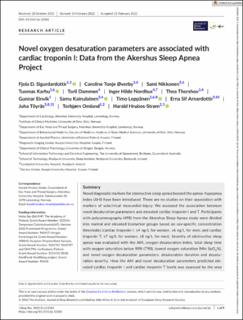| dc.description.abstract | Novel diagnostic markers for obstructive sleep apnea beyond the apnea–hypopnea index (AHI) have been introduced. There are no studies on their association with markers of subclinical myocardial injury. We assessed the association between novel desaturation parameters and elevated cardiac troponin I and T. Participants with polysomnography (498) from the Akershus Sleep Apnea study were divided into normal and elevated biomarker groups based on sex-specific concentration thresholds (cardiac troponin I: ≥4 ng/L for women, ≥6 ng/L for men; and cardiac troponin T: ≥7 ng/L for women, ≥8 ng/L for men). Severity of obstructive sleep apnea was evaluated with the AHI, oxygen desaturation index, total sleep time with oxygen saturation below 90% (T90), lowest oxygen saturation (Min SpO2%), and novel oxygen desaturation parameters: desaturation duration and desaturation severity. How the AHI and novel desaturation parameters predicted elevated cardiac troponin I and cardiac troponin T levels was assessed by the area under the curve (AUC). Based on multivariable-adjusted linear regression, the AHI (β = 0.004, p = 0.012), desaturation duration (β = 0.007, p = 0.004), and desaturation severity (β = 0.147, p = 0.002) were associated with cardiac troponin I levels but not cardiac troponin T. T90 was associated with cardiac troponin I (β = 0.006, p = 0.009) and cardiac troponin T (β = 0.005, p = 0.007). The AUC for the AHI 0.592 (standard error 0.043) was not significantly different from the AUC of T90 (SD 0.640, p = 0.08), desaturation duration 0.609 (SD 0.044, p = 0.42) or desaturation severity 0.616 (SD 0.043, p = 0.26) in predicting myocardial injury as assessed by cardiac troponin I. Oxygen desaturation parameters and the AHI were associated with cardiac troponin I levels but not cardiac troponin T levels. Novel oxygen desaturation parameters did not improve the prediction of subclinical myocardial injury compared to the AHI. | en_US |

